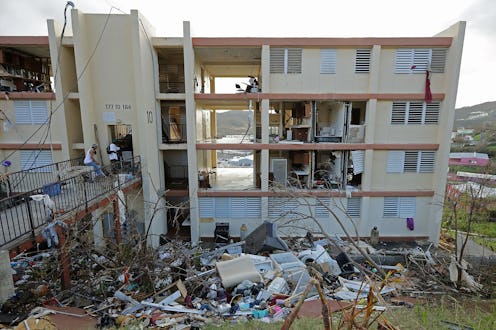News
What You Need To Know About Hurricane Maria & The United States

With Hurricane Harvey and Hurricane Irma recoveries underway across the southeastern United States, the possibility of a repeat is the last thing anyone wants to deal with. But Mother Nature isn't too worried about taking the earlier hurricanes this season into consideration. But for those affected by Harvey in Houston, Texas, Hurricane Maria shouldn't be much of a concern. For those who felt the worst of Hurricane Irma, that's another story.
Maria seems to largely be following Irma's path thus far. While Harvey stayed south in the Caribbean, hugging the coast of Venezuela, Maria has headed towards the north. It's going to hit the Leeward Islands first — the same archipelago that saw the very worst of Hurricane Irma, like Antigua and Barbuda. They will very likely be affected this time around too. Then it will move up to the equally devastated St. Martin, before it makes contact with U.S. soil, likely hitting Puerto Rico and the U.S. Virgin Islands.
At the time being, the storm is not as strong as either Harvey or Irma grew to be. But that could change. The National Hurricane Center said Monday, "Maria is currently a Category 2 hurricane on the Saffir-Simpson Hurricane Wind Scale. Additional rapid strengthening is forecast during the next 48 hours, and Maria is expected to become a dangerous major hurricane before it moves through the Leeward Islands."
So by the time it reaches the first Caribbean Islands it could be much stronger. That would be bad news for Puerto Rico, an island (and U.S. territory) that was spared the worst of Irma, when the eye passed off the coast. Already there's a hurricane watch there because of Maria; it should hit sometime early Wednesday.
Puerto Rican Gov. Ricardo Rosselló addressed the public via Facebook, noting that "the government is prepared." He added, "We ask of the citizenship preparation, attention, and action." He gave a news conference on Sunday, too, warning that Maria could bring even worse conditions than Irma did — more rain, wind, and surf.
That recovery effort is still well underway on the island, where three people were killed. About 85 percent of San Juan is without power still, some 46,000 people. Another 6,000 are without water. NBC News reported that FEMA is headed to the island with drinking water and generators, plus there are shelters on the island that can accommodate 67,000 people.
On the U.S. Virgin Islands, officials are speaking direly about what another storm could bring. Governor Kenneth Mapp released a statement telling people to leave. "It's critical people make the tough decision to walk away from their property and take along what is most important — their loved ones," his office said in a statement.
That's not always easy to do. Because of the coming storm, federal aid boats haven't been able to stay in the U.S. Virgin Islands, and so many people are stranded on the smaller islands like St. John. Private companies have ferried people to safety, but many wonder why the U.S. Navy hasn't done more. U.S. Rep. Stacey Plaskett, the delegate to Congress explained to USA Today that Florida and Texas are getting the bulk of resources. For some, staying isn't a feasible option. The only hospital was closed by Irma.
Once Maria moves through these areas of the Caribbean — already dealing with such damage — it's unclear exactly where it will head next. It's thought to head more to the north than Irma did, but anything's still possible. The Weather Channel is telling everyone on the Gulf and East coasts to prepare for the storm to make landfall.
And as has been seen with these past storms, preparation is key.